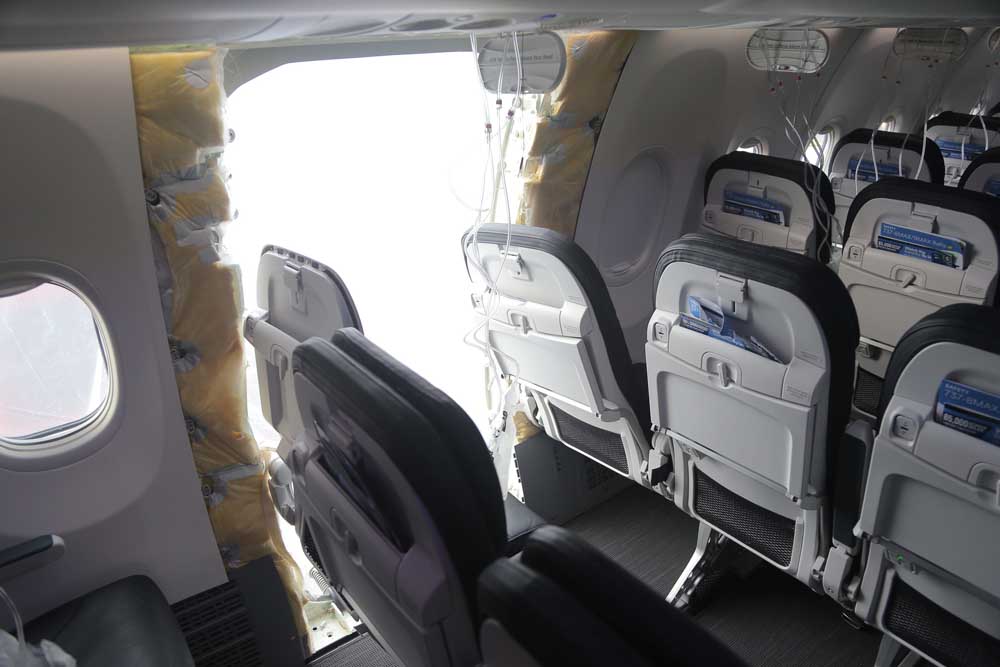What happened on the Alaska Airlines flight after the door plug blew out?
Published 9:16 am Wednesday, January 10, 2024

- This image from the National Transportation Safety Board shows the hole in the side of the Alaska Airlines Boeing 737-9 Max.
Terrifying tales from passengers on an Alaska Airlines flight after a gaping hole opened in the aircraft prompted many people to wonder: How did everyone survive?
The midair accident Friday could have been much worse, experts say, if the plane had already reached its higher cruising altitude, where the decompression could have happened with much greater force and could have pulled passengers out of the aircraft. But the plane was only at 16,000 feet and still ascending. The air pressure in many commercial airline cabins is typically equal to 8,000 feet in altitude.
Trending
“The pressure difference between 8,000 feet and 16,000 feet was not great enough to cause that kind of force to suck someone out the window,” said Jeff Guzzetti, a former accident investigator with the Federal Aviation Administration and the National Transportation Safety Board.
Here’s what happens inside the cabin of an aircraft when a hole suddenly opens.
What happened on the Alaska Airlines flight?
Only a few minutes after the plane departed in Portland on Friday, a door plug — an exit sealed with a panel rather than used as a door — blew out about halfway down the fuselage of the aircraft. That left a gaping hole directly next to a row of seats. No one was sitting right next to the missing door plug.
Oxygen masks dropped from above, and pilots quickly lowered the plane’s altitude and made an emergency landing back in Portland.
What happens when a hole opens in a plane midair?
Trending
Commercial airplane cabins have pressurized air so passengers and crew can breathe easily and maintain normal oxygen levels even while flying at a cruising altitude of more than 30,000 feet.
The air in many planes is kept at about the same pressure as what people experience at 8,000 feet above sea level, which maintains normal physiological functions, said Scott Wagner, an assistant professor at Embry-Riddle Aeronautical University’s College of Aviation.
If a hole opens up, the air inside the cabin tries to equalize with the lower-pressure air outside the aircraft. Warmer, pressurized air escapes from the cabin, leaving passengers to deal with dropping temperatures and less oxygen.
Three types of depressurization, or decompression, can occur on planes: gradual, rapid or explosive. The Alaska Airlines flight experienced a rapid decompression, according to the FAA, meaning it takes more than half a second — and often much longer — for the cabin to depressurize.
Why weren’t the injuries more severe?
The incident happened minutes after takeoff, with the flight at 16,000 feet in altitude, so the difference in pressure between the air inside the cabin and the air outside was smaller than it would have been at a much higher cruising altitude. That means the depressurization happened with less force than it would have if the plane was flying higher.
Alaska Airlines reported that several people on the flight experienced injuries, but all had been medically cleared by Saturday evening. One passenger’s phone was found on the ground, unbroken, over the weekend. Another report states that one passenger’s shirt was sucked out of the open hole. Some passengers described debris flying through the plane, and investigators said that headrests of two seats and the back of one were discovered to be missing after the accident.
And if the blowout had occurred later in the flight, passengers may have been walking down the aisles, leading to much more potentially catastrophic results.
“At cruising altitude, anyone who wasn’t belted in or strapped down would have gone right out the opening,” said Jeremy Laliberte, a professor of mechanical and aerospace engineering at Carleton University.
The depressurization would have been more explosive at a higher altitude as well, potentially ripping more of the airplane’s wall off, Laliberte said.
Planes are designed to be able to fly even if parts of the fuselage are missing. In 1988, an Aloha Air plane lost an entire section of its roof. A flight attendant was killed, but everyone else survived, and the pilots safely landed the plane. In 2011, a Southwest plane made an emergency landing after part of the plane’s roof was ripped off.
And in 2018, a Southwest passenger died after she was partially sucked out of a broken window when the plane was at cruising altitude. The pilot made an emergency landing and no one else on the plane died.
What do pilots do in the case of a rapid decompression?
In the case of a cabin decompression, pilots often try to get the aircraft to lower altitudes — preferably at or below 10,000 feet, where people can breathe more easily.
In this case, pilots appeared to act quickly after the door plug blew out.
“We just depressurized; we’re declaring an emergency,” the Alaska pilot told air traffic controllers, according to recordings from LiveATC.net. “We need to descend down to 10,000.”
The missing section of the fuselage would have created some drag on that side of the plane, making it slightly more difficult to fly, Laliberte said. But pilots are trained to account for problems like that and still fly safely, he said.
Alaska Airlines Flight 1282 descended and landed again in Portland about 20 minutes after it had first taken off.








